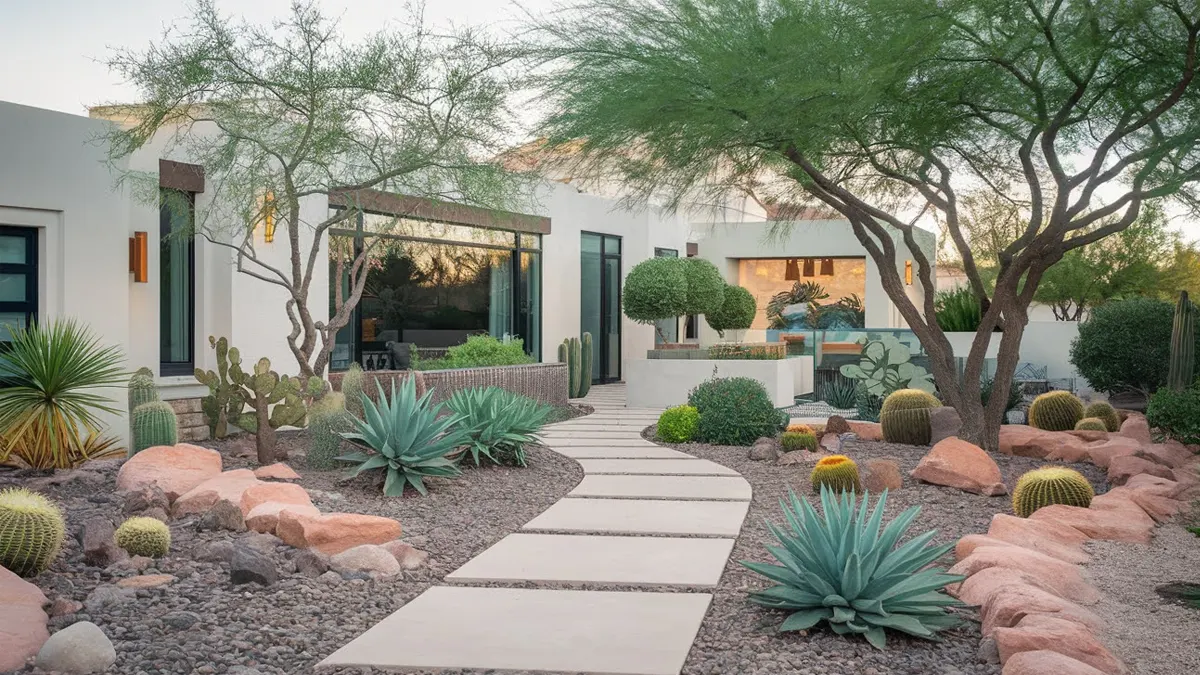Desert landscaping is perfect for dry climates like Las Vegas: stylish, low-maintenance, and water-saving. With the right mix of plants, rocks, and creative features, you can turn your front yard into a stunning desert oasis.
Ready to make your front yard both practical and beautiful? Check out these innovative ideas!
- Shapes to Elevate Your Desert Yard
- Modern Rock Gardens for Desert Landscaping
- Succulents & Cacti for Easy Style
- Dry Creek Beds for Beauty & Function
- Shade & Fire Features for Desert Living
- Gravel & Mulch for Easy Maintenance
- Native Wildflowers for Color
- Hardscaping for Style & Structure
- Water Features for Curb Appeal
- Textures & Layers for Desert Charm
1. Shapes to Elevate Your Desert Yard

Desert landscaping thrives on contrasts. Use soft, flowing curves for pathways and garden beds, then pair them with crisp, angular hardscaping for a modern aesthetic.
Gravel pathways, stone pavers, and defined garden borders are excellent tools for creating these visual contrasts. Incorporate plants like yucca or agave along curves to bring out their natural shapes while hardscaping anchors the design.
2. Modern Rock Gardens for Desert Landscaping
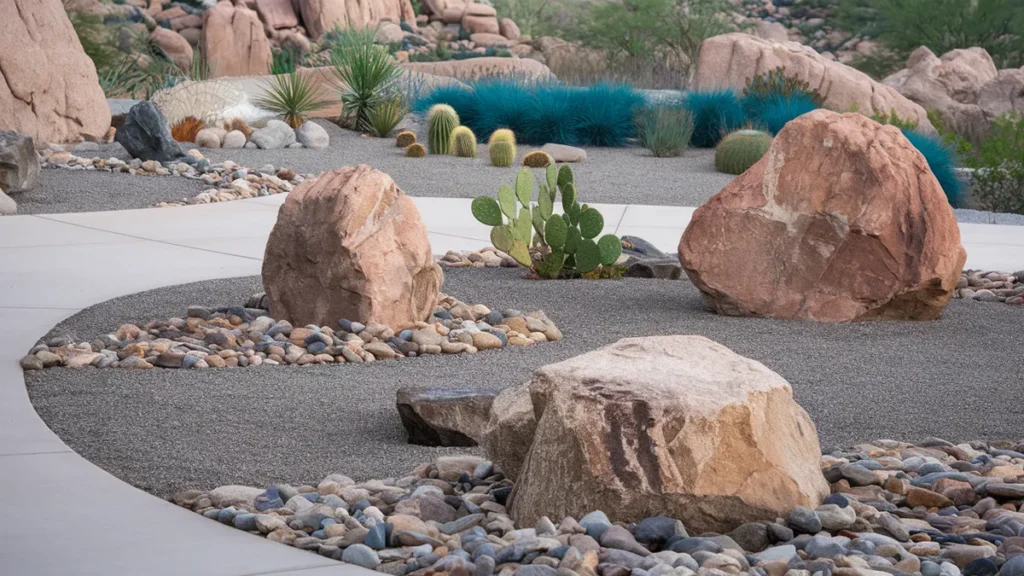
Rock gardens are the centerpiece of many desert landscapes, offering both texture and dimension.
Use a mixture of boulders, river stones, and crushed gravel to craft an eye-catching feature. Arrange larger rocks as focal points, with smaller ones scattered around them for a natural look.
Pair the rocks with drought-tolerant plants like prickly pear cactus, golden barrel cactus, or blue fescue for added color and variety.
3. Succulents & Cacti for Easy Style
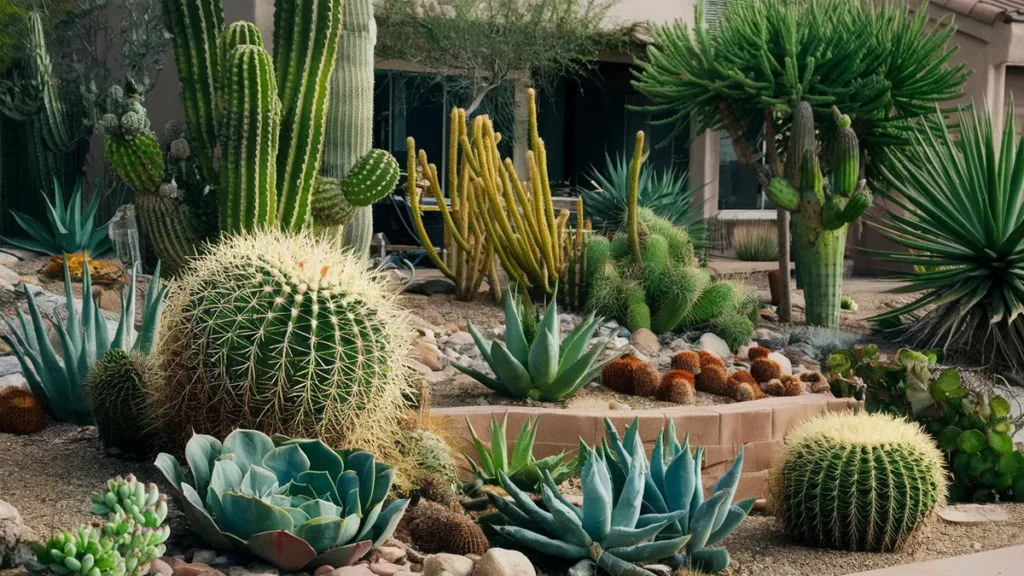
No desert landscape is complete without succulents and cacti. These low-maintenance plants thrive in hot, dry climates and add bold texture and visual interest.
Choose a variety of shapes and sizes, from tall, dramatic saguaros to ground-hugging echeverias. For extra flair, group plants with similar water needs and use pots or raised beds to create a layered effect.
4. Dry Creek Beds for Beauty & Function
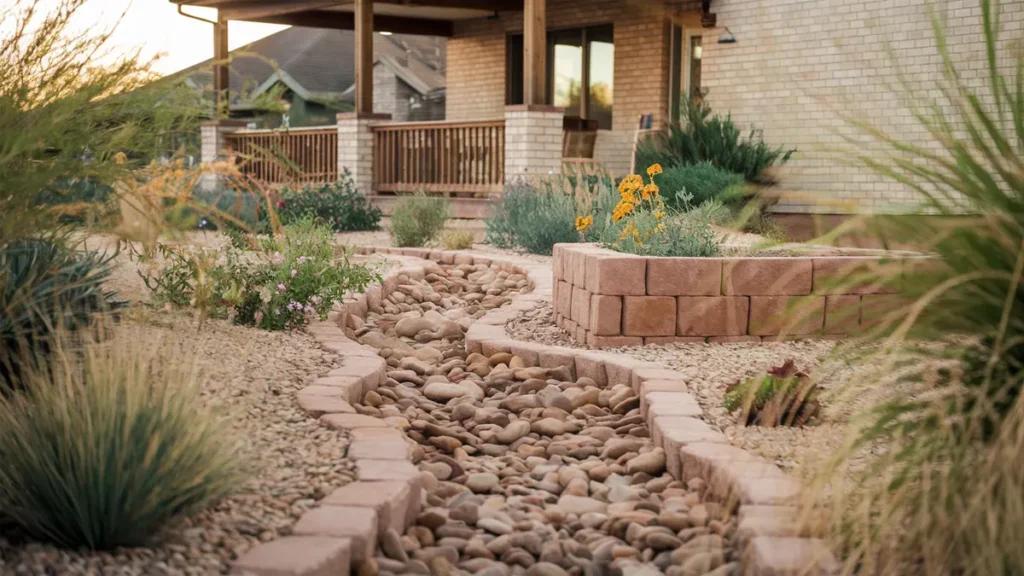
Dry creek beds do more than look great, they also help manage rainwater during rare desert storms.
Use smooth river stones to mimic the natural flow of a creek, and frame it with desert grasses or flowering plants like desert marigold. This feature adds movement to your design while serving a practical purpose in improving drainage.
5. Shade & Fire Features for Desert Living
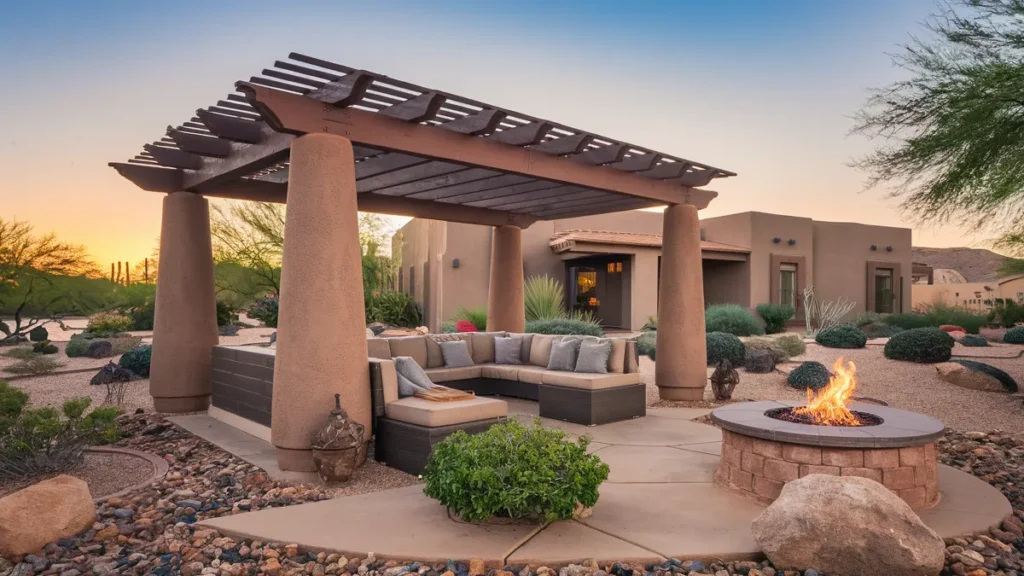
Make your desert front yard both stylish and functional with features that help you enjoy the outdoors all year.
Add a pergola for much-needed shade during hot afternoons or a fire pit for cozy nights under the stars. Pair these with durable, weather-resistant seating to create a space that’s perfect for relaxing or entertaining.
These additions not only handle the desert heat but also elevate the look and feel of your outdoor space.
6. Gravel & Mulch for Easy Maintenance
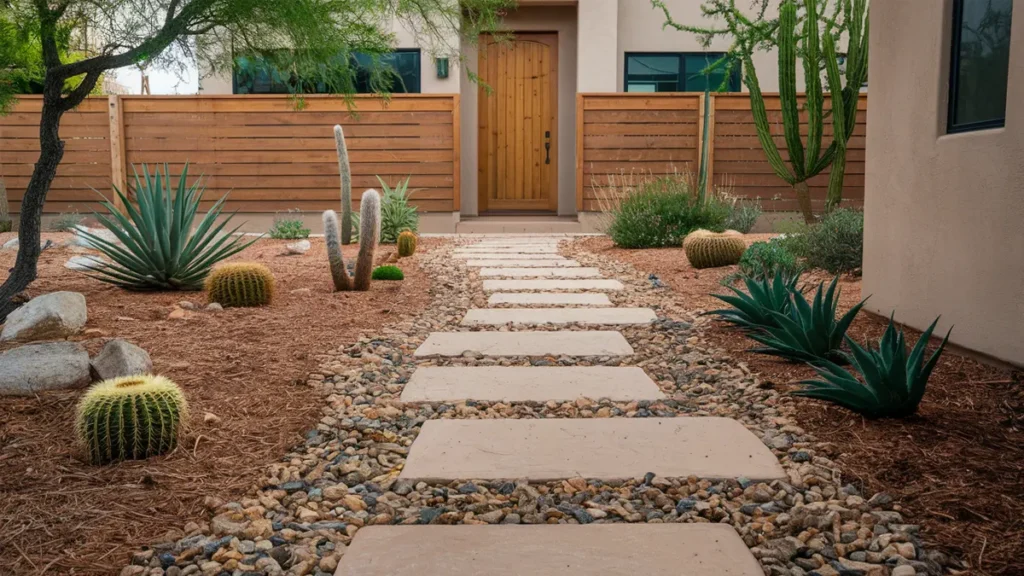
Gravel and natural mulch are essential for desert landscaping. They help retain soil moisture, prevent weeds, and reduce water evaporation.
Choose gravel in earthy tones like tan, gray, or rust to match the desert aesthetic. Use mulch around plants to improve soil health while keeping the yard looking tidy and polished.
7. Native Wildflowers for Color
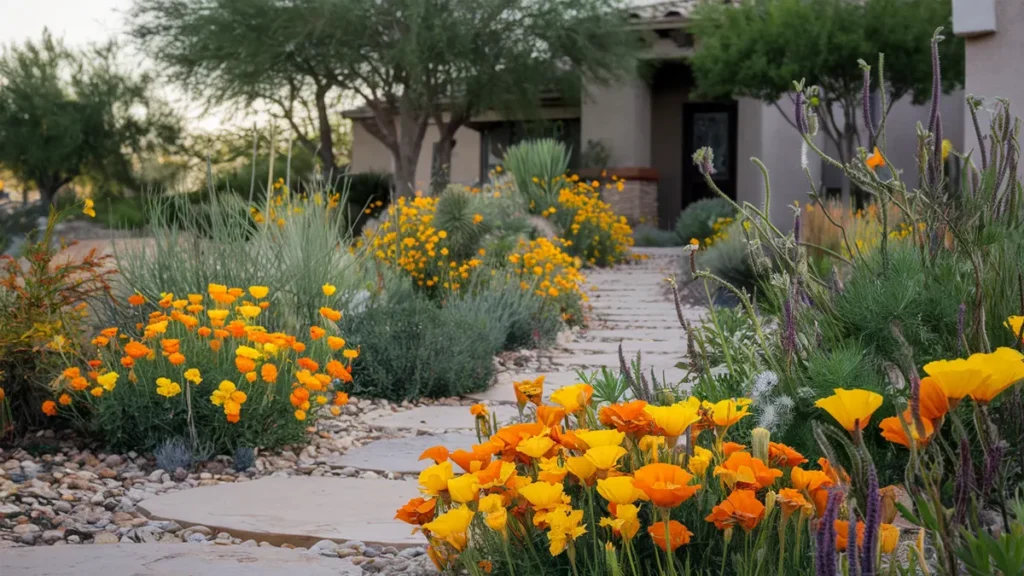
While desert landscapes are often associated with neutral tones, adding native wildflowers can infuse vibrant color into your yard.
Drought-resistant blooms like desert marigold, penstemon, or Mexican poppies can thrive with minimal water while attracting pollinators like bees and butterflies.
Plant them in clusters or along pathways for a lively, natural look. You could also plant them close together for water efficiency and a fuller look.
8. Hardscaping for Style & Structure
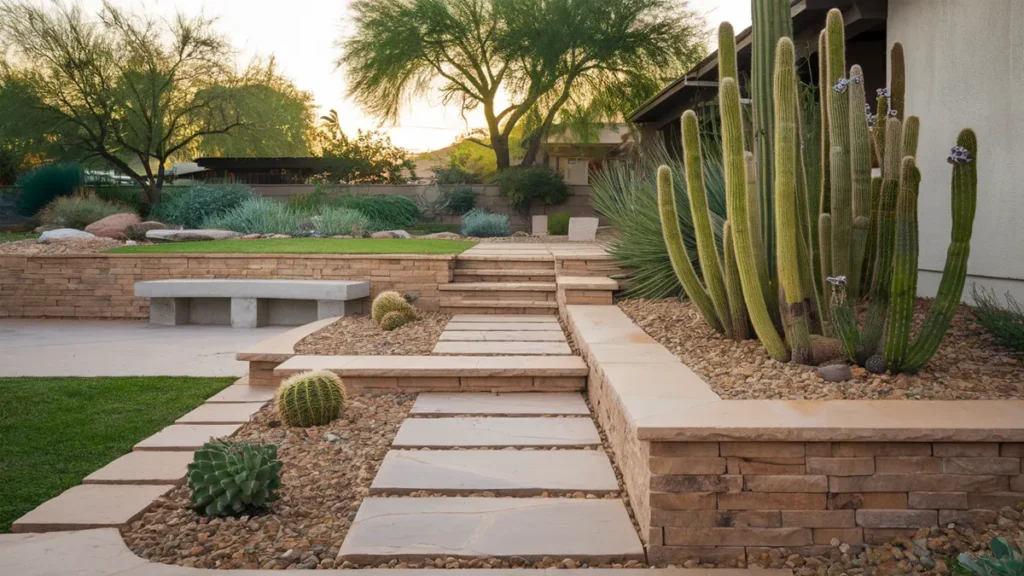
Hardscaping elements like pathways, patios, and retaining walls add both structure and curb appeal to desert landscapes.
Materials like natural stone, concrete, or terracotta can define spaces and create visual interest. A stone pathway winding through your yard can draw the eye while retaining walls can elevate plants and add dimension to your outdoor design.
9. Water Features for Curb Appeal
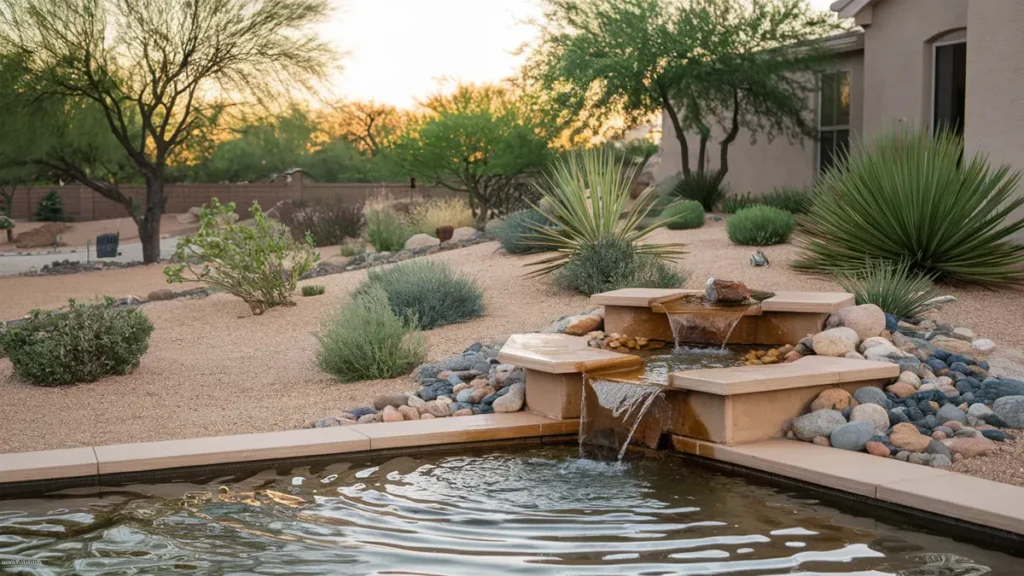
A small water feature can elevate your yard from ordinary to extraordinary. While desert landscaping focuses on water conservation, features like fountains, bubbling rocks, or reflective pools can be added as focal points.
These features provide soothing sounds, create a cooling effect, and offer a striking contrast to the dry landscape around them.
10. Textures & Layers for Desert Charm
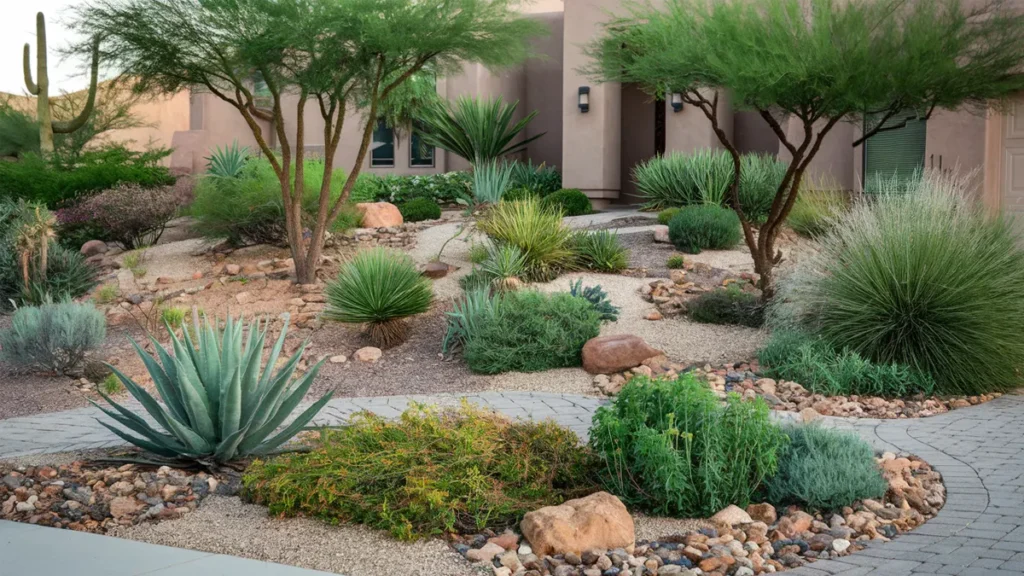
Desert landscaping doesn’t have to be flat or one-dimensional. Combine plants of different heights, textures, and colors to create a layered effect.
Tall plants like ocotillo or mesquite trees can serve as anchors, while mid-sized shrubs and ornamental grasses fill in the middle. Use groundcovers like creeping thyme or sedum to complete the look and reduce exposed soil.
Frequently Asked Questions
What is Desert Landscaping Called?
Desert landscaping is often referred to as xeriscaping. It’s a sustainable approach that minimizes water usage by incorporating drought-tolerant plants and efficient irrigation systems.
This method is particularly beneficial in arid regions, like Las Vegas, as it reduces the need for extensive watering and maintenance
How do you Add Color to a Desert Landscape?
Adding color to your desert landscape is simpler than it seems. Along with colorful stones and gravel, you can incorporate vibrant plants like Grape Ivy, Primrose Jasmine, and Queen’s Wreath.
These desert plants thrive in the hot sun and require minimal water, making them perfect for low-maintenance, colorful accents in your front yard. By blending these hardy plants with your landscape design, you can create a stunning, vibrant environment without compromising on water conservation.
Does Front Yard Landscaping Increase Home Value?
Yes, front yard landscaping can significantly boost your home’s value. According to the American Society of Landscape Architects, professional landscaping can increase a home’s resale value by 15% to 20%.
On the flip side, poor landscaping can have the opposite effect, with property values potentially dropping by up to 30% due to neglected or unappealing landscapes. Proper care and design can make a huge difference in both the aesthetic appeal and market value of your home.

